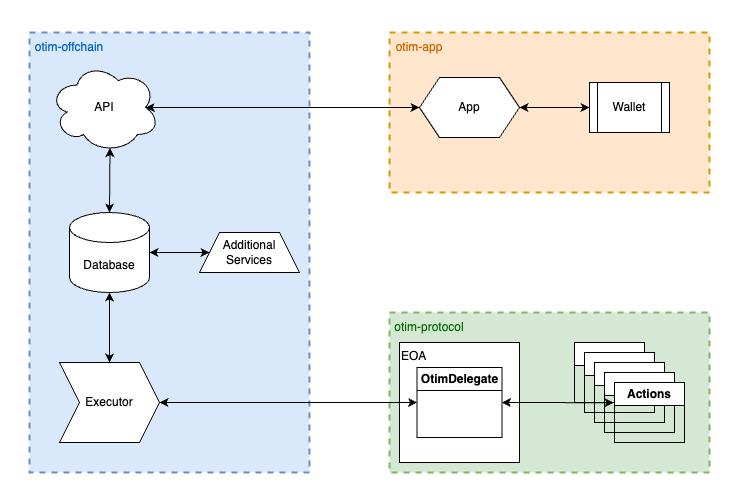Otim: A Bird’s Eye View
Otim’s operating system is enabled by a new Ethereum upgrade called EIP-7702. This upgrade allows Externally Owned Accounts (EOAs), the most common type of account, to act like smart contracts for the first time.
Dave Carroll
Adam Carlson

Otim’s operating system is enabled by a new Ethereum upgrade called EIP-7702. This upgrade allows Externally Owned Accounts (EOAs), the most common type of account, to act like smart contracts for the first time.
Before EIP-7702, EOAs were incapable of automation. They couldn’t do specific tasks on their own, which meant they lagged far behind traditional finance. An EOA user couldn’t set up a recurring subscription, schedule automatic swaps, or do anything that required their account to act independently. Every transaction needed manual approval. Smart contract accounts could automate these tasks, but using them meant transferring your money to accounts that weren’t truly yours. EIP-7702 finally changed this.
EIP-7702 allows your EOA to temporarily copy the behavior of any smart contract. When a smart contract exists on Ethereum, your EOA can now look at that contract's code and run it as if it were its own. This is called "delegating" your account to a smart contract.
At Otim, we use a helpful metaphor: EIP-7702 lets your EOA put on an Iron Man suit. The account underneath stays the same– it's still your account with your money. But the smart contract “suit” gives your account newfound superpowers.

Our goal is simple: automate your finances the way traditional finance already works. We've created smart contracts that your EOA can delegate to, unlocking powerful financial actions like automatic swaps, transfers, bill payments, and account refueling.
Think of it like this: Otim provides the Iron Man suit, and you choose which weapons to use based on what you want to accomplish.
Smart Contracts on Otim
Our protocol centers around one primary smart contract that users delegate their accounts to, OtimDelegate. This contract contains all the logic for validating, executing, and managing the automated instructions you create. It’s the brain that makes everything work.
We also use several “helper” contracts:
InstructionStorage: Stores the execution state of your instructions (inactive, active, deactivated, etc.)
ActionManager: Controls which actions can be executed, protecting users from buggy or malicious code.
Treasury: Collects fees from instruction executions.
Instructions vs. Actions

Let's use a restaurant to explain the two key concepts in Otim:
Actions are like dishes on a menu. They're the different financial operations available to you: transfer money, swap tokens, pay bills, refuel accounts. Each action is a piece of code that knows how to perform one specific task.
Instructions are like orders you give to the waiter. You choose an action (the dish) and customize it for your needs: "I want to transfer $100 to my savings account every month" or "Swap $50 of ETH for USDC every Friday."
Once you place your order (create an instruction), the restaurant kitchen (Otim protocol) keeps preparing that dish (executing the action) according to your specifications until you decide to cancel or modify your order.
From a user’s perspective, Otim is incredibly simple:
Choose your tool: Delegate your EOA to the OtimDelegate contract
Place your orders: Create customized instructions using the Otim app
Relax: Your instructions execute automatically according to your specifications
You might tell Otim to set up a $15 payment to Netflix every month, then forget about it entirely as you binge your favorite shows. The protocol handles everything behind the scenes.
Your Entry Points into Otim
There are several ways to start using the Otim operating system:
- Simple transfers: Set up recurring payments to friends, family, or services
- Automated investing: Dollar-cost average into your favorite tokens on a schedule
- Account management: Automatically refuel gas accounts or rebalance portfolio allocations
- Bill payments: Pay or request invoice payments
Each of these represents a different "Iron Man weapon" that’s in your suit, giving your EOA the specific superpowers you need.
How It All Comes Together

If we look at the diagram above, we see the three building blocks of the Otim ecosystem: the smart contracts we’ve discussed (green), the Otim App where you create your instructions (orange), and the backend services that make everything run smoothly (blue).
Returning to our restaurant metaphor: the Otim App is where you browse the menu and place your orders. The backend services are like the restaurant staff—the API acts as your waiter, taking your order to the kitchen (database) and telling the chef (executor) to prepare your meal. The chef then serves your dish by executing your instructions on the blockchain through the smart contracts.
The beauty of this system is that once you've placed your order through the app, everything else happens automatically behind the scenes.
Otim transforms your simple Ethereum account into a financial powerhouse that works for you 24/7. By leveraging EIP-7702, we've built an operating system that brings the convenience of traditional finance to the crypto world—but with the control, transparency, and ownership that only comes with decentralized systems.
Your account, your rules, fully automated.